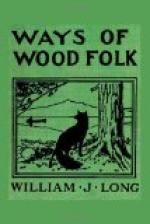I sat down on the outer edge of a pine thicket, and became as much as possible a part of the old stump which was my seat. Just in front an old four-rail fence wandered across the deserted pasture, struggling against the blackberry vines, which grew profusely about it and seemed to be tugging at the lower rail to pull the old fence down to ruin. On either side it disappeared into thickets of birch and oak and pitch pine, planted, as were the blackberry vines, by birds that stopped to rest a moment on the old fence or to satisfy their curiosity. Stout young trees had crowded it aside and broken it. Here and there a leaning post was overgrown with woodbine. The rails were gray and moss-grown. Nature was trying hard to make it a bit of the landscape; it could not much longer retain its individuality. The wild things of the woods had long accepted it as theirs, though not quite as they accepted the vines and trees.
As I sat there a robin hurled himself upon it from the top of a young cedar where he had been, a moment before, practising his mating song. He did not intend to light, but some idle curiosity, like my own, made him pause a moment on the old gray rail. Then a woodpecker lit on the side of a post, and sounded it softly. But he was too near the ground, too near his enemies to make a noise; so he flew to a higher perch and beat a tattoo that made the woods ring. He was safe there, and could make as much noise as he pleased. A wood-mouse stirred the vines and appeared for an instant on the lower rail, then disappeared as if very much frightened at having shown himself in the sunlight. He always does just so at his first appearance.
Presently a red squirrel rushes out of the thicket at the left, scurries along the rails and up and down the posts. He goes like a little red whirlwind, though he has nothing whatever to hurry about. Just opposite my stump he stops his rush with marvelous suddenness; chatters, barks, scolds, tries to make me move; then goes on and out of sight at the same breakneck rush. A jay stops a moment in a young hickory above the fence to whistle his curiosity, just as if he had not seen it fifty times before. A curiosity to him never grows old. He does not scream now; it is his nesting time.—And so on through the afternoon. The old fence is becoming a part of the woods; and every wild thing that passes by stops to get acquainted.
I was weaving an idle history of the old fence, when a chickadee twittered in the pine behind me. As I turned, he flew over me and lit on the fence in front. He had something in his beak; so I watched to find his nest; for I wanted very much to see him at work. Chickadee had never seemed afraid of me, and I thought he would trust me now. But he didn’t. He would not go near his nest. Instead he began hopping about the old rail, and pretended to be very busy hunting for insects.




